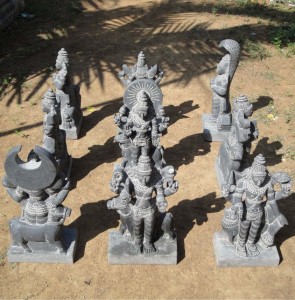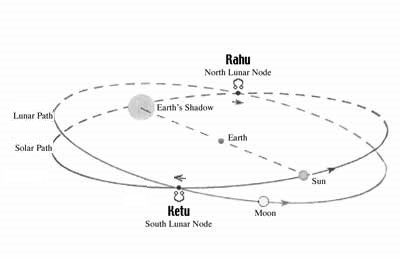
Hinduism and astrology are still intimately connected. In the past it was common that astrology and religion were related, even within Christianity, but over time astrology became separated and even rejected from many religious cultures, including Judaism and Christianity. In the case of Hinduism, however, this never happened, and to this day astrology has remained a vibrant part of the religion. Even now, most educated Hindus will seek astrological advice at some point in their lives. One of the key components of astrology are theNava Grahas. Most Hindus think of the Nava Grahas as the nine planets. The word nava does mean nine, but graha does not directly mean planet. Instead, graha, comes from the Sanskrit root grih which means “to seize” or “to take hold of.” Literally, these nine “planets”are nine “seizers,” so if we can be seized or taken hold of, we can be influenced. The Nava Grahas are, therefore, the nine influences over our lives. In the early days of Hinduism, the tradition speaks of the enlightened seers, rishis, who looked out across physical reality and saw that life was “influenced” by different forces, and of all the forces that influenced life, nine were the most influential, and so they were called the nava grahas, “the nine influences.” These nine influences are: the sun, the moon, Mars, Mercury, Jupiter, Venus, Saturn, Rahu and Ketu. This is the Hindu order and it follows the days of the week in most Indian and even many European languages. Sunday, for example, is governed by the sun, hence the name Sunday. Monday is governed by the moon, (add an extra “o” and you get moon-day); Tuesday by Mars (Martes in Spanish); Wednesday by Mercury (Miércoles); Thursday by Jupiter (Jueves, Jovian for Jupiter); Friday by Venus, (Viernes), and Saturday, of course, is governed by Saturn. In addition, to these seven points of influence, there are two others called Rahu and Ketu that are a little more difficult to understand.
Rahu and Ketu

It is a common mistake to think that the nine planets (now eight) that we used to hear about in Western astronomy are the same as the Nava Grahas of Hinduism. There is no Uranus, Neptune or Pluto in ancient Hinduism. (They were added later.) In spite of this, even in Hindu temples, one sees the two Hindu grahas, Rahu and Ketu often misunderstood as Pluto or Neptune. In Hindu mythology, Rahu and Ketu are described as two parts of a great demon who swallow up the sun and moon. These grahas are described as invisible or shadowy planets because they cannot be observed like the other grahas, but in fact, they are mathematical points of calculation. Imagine the path of the sun across the sky as a great wheel in the heavens. This path is called the solar ecliptic. Now imagine a similar path of the moon as it makes its monthly journey across the sky. Where the moon’s path crosses the sun’s path at the top of the circle is called the point of Rahu, and 180 degrees to the south, where these two lines again intersect is called Ketu. In modern astronomy these points are called the north and south lunar nodes. Hindu astrology considers these points to exert influence over life and so they are considered two important points of influence. They are, consequently, part of the Nava Grahas. Neither the sun, the moon, Rahu or Ketu are planets, nor does the word graha mean planet in the same sense that we understand the world planet today, and so this is why it is incorrect to call the Nava Grahas nine “planets.” In Hindu mythology Rahu and Ketu chase the sun and the moon across the heavens, and from time to time, swallow them up and cause a solar or a lunar eclipse. In fact, Rahu and Ketu do play a role in eclipses because it is only when the sun and the moon align at the points of Rahu and Ketu, the north and south lunar nodes, that an eclipse can take place.
The Danger from Solar and Lunar Eclipses
There is a common Hindu belief that it is inauspicious and dangerous to look at an eclipse or even to be outside in the light of an eclipse. Temples close, homes lock their doors and shade their windows, people are told not to eat, and it is thought to be an especially dangerous time for pregnant women. After the eclipse temples and homes are washed and pujas are performed to purify the atmosphere. As noted above, during an eclipse, Rahu or Ketu “swallow” up the sun or the moon, and because their influences are highly negative, their mixture with the sun’s or the moon’s light creates highly toxic rays of light that reach the earth. It is said that these rays contaminate wherever they strike and cause all kinds of havoc, including even miscarriages and deformities in pregnant females. This is the reason that eclipses are considered inauspicious and why people should not eat or travel in the open during an eclipse.
Nava Graha Murtis Installed in Temples
It is common to see the Nava Grahas installed as murtis in Hindu temples and people will perform pujas to thesegrahas in order to propitiate these influences. It is often the case that a Hindu will consult an astrologer and be told that one of the grahas is exerting a negative influence over his life and that he should perform a puja in order to diminish the negative influence. Occasionally, even the reverse is true, someone may be told that a particular graha is exerting a positive influence and so the person may perform a puja to increase the positive influence. There is a popular puja called “Graha Shanti” to make peace with the grahas (shanti means peace) that is often performed before weddings and other important times. You can think of a Nava Graha puja as paying the cosmic “utility bill.” Indeed, the Nava Grahas still play an important role in Hinduism.
From an astrological perspective here is how these nine grahas are understood in Hindu astrology. The sun represents the soul, the heart, the father, authority, heat, power and ambition. The moon is the mind, mother, water, coolness, emotions, memory and common sense. Mars is courage, bravery, sports, competition, maleness, passion, action, war, cuts and burns. Mercury is intelligence, learning, teaching, speech, expression, communication and writing. Jupiter is fortune, expansion, wealth, children, religion, philosophy and wisdom. Venus is marriage, love, romance, luxuries, prosperity, femininity, artistic expression, grace, and beauty. Saturn is slowness, struggle, discipline, dryness, labor, asceticism, accidents, and chronic disease. Rahu is material desire, dullness, ignorance, laziness, sleep and addictions and ancestral karma. Ketu is asceticism, spirituality, psychic ability, ghosts, eccentricity and occultism. For more details see the section entitled, Hindu Astrology.